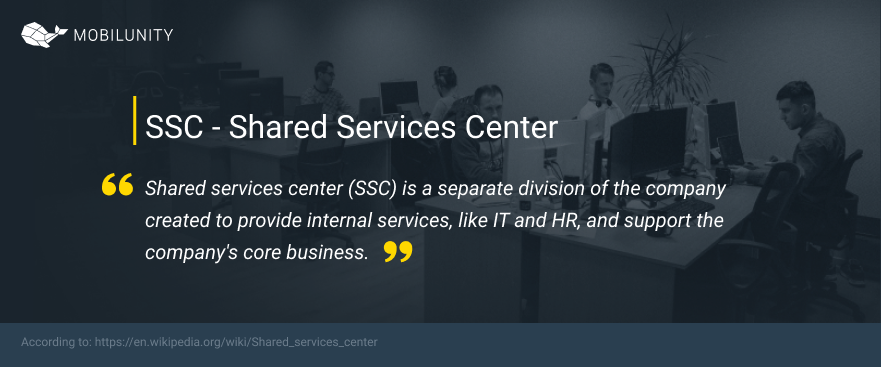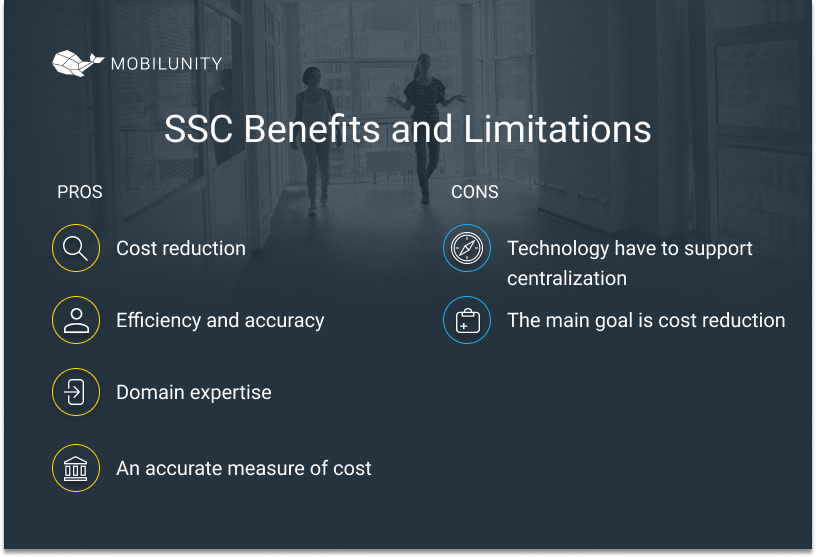SSC (Shared Services Center)
SSC means a shared service center. It is a separate division of the company created to provide internal services, like IT and HR, and support the company’s core business [1]. SSC meaning is similar to outsourcing when certain functions of the organization are transferred to the third-party contractors. But in this case, the contractor is a part of the organization and is fully subordinated to its management.
History of the Shared Services Center Model
The United States became the first country whose economic entities switched to this form of interaction [2]. The first centers serving the auxiliary processes of large corporations on SSC terms appeared in the second half of the twentieth century, for example, company General Electric – from the early 70s [3]. In Europe, this process began much later, although its intensity in modern conditions is comparable to that of the United States.
The main reasons for the creation of SSC were the need for savings through centralization, elimination of duplication, and obtaining funds to invest in the latest technology. Associated with this was a focus on process improvement, with efforts focused on areas where it seemed to have the greatest potential.
Also, standardization is ranked among the key reasons. It was necessary to ensure that all parts of the business followed the same process and there was a mechanism to regulate users’ behavior.
How Does the Shared Services Center Model Work?
There is a hybrid shared services model: the creation of SSCs in the company and the selective use of business process outsourcing. There are also more complex multi-layer models. For example, the financial function of the car manufacturer Damlier is managed by the Group’s Single Service Center in Berlin [4], which allows it to carry out specific, high-level functions that require knowledge of the German language.
Most often, supply and procurement functions are transferred to a SSC, which allows a business to save on volumes. The SSC model is widespread in the supply chain, legal support, and work with clients. For example, Boeing, which delegated support to the SSC, has cut its spending by $1.4 billion since 1998 [5].
What Are the Reasons to Deploy SSC?
a. to reduce costs
Reducing costs is possible due to: transferring staff to less costly regions, optimizing working hours, reducing the requirements and number of licenses, automatization of key processes, and modernizing systems, reducing the cost of renting premises.
b. to standardized processes
The consolidation of support functions in the SSC allows companies to focus on core business, which is profitable, and to devote more time to the strategic development of the enterprise. Standardization and automation of business processes have a positive effect on the quality of internal services. This approach allows you to avoid errors in the process of processing requests, reduce the time spent on the task, and increase the productivity of employees. All this, as a result, can significantly reduce the business cost for operating activities.
c. to improve the quality of delivered services
The above reasons in combination can significantly increase the investment attractiveness of both the company as a whole and individual enterprises that have switched to service in a common center. Moreover, when expanding the business and acquiring new enterprises, the SSC technology will allow the fastest possible integration of new links into the existing technological and managerial hierarchy of the company.
What Are the SSC Market Size and Trends Worldwide and in Ukraine?
The USA occupies the top place as SSC locations followed by India and Poland [2]. It is noted that the USA and Poland are preferred due to proximity to headquarters and better regulatory/legal understanding of the respective markets. India remains a relatively low-cost option and continues to be one of the more popular SSC locations due to labor availability and language capabilities.
Such companies as AB InBev, Gruma, Nestle and VEON (Kyivstar) have already set up SSCs in Ukraine. For instance, Gruma was looking for specialists in Cherkassy as they needed to support finance services in Italian, Turkish and English in order to service Gruma EMEA [6].
While India continues to be a preferred location for offshoring, companies also observe Poland, Spain, and the UK for Europe; this trend is also witnessed among companies that have global operations. Over 30% of shared services centers are expected to be established globally by 2022 [7].
Benefits and Limitations of Shared Services Centers
Among benefits are:
- Cost reduction. There is a cost advantage if the SSC model is implemented correctly.
- Efficiency and accuracy. Among shared service solutions are avoidance of duplication, inconsistency, and conflict of systems.
- Domain expertise. State-of-the-art experts can create a competitive advantage in rewards, and processes.
- An accurate measure of cost. Centralization promotes understanding, service level agreements, and associated metrics which lead to the increased visibility of the cost equation of internal services.
Limitations include:
- Technology, systems, tools, and management capability have to support centralization. Lack of this can slow down shared services implementation, add unwanted complexity to the growth and development of a company.
- The main goal is cost reduction. Such an approach creates disability for a company as a competitive position is compromised. Companies must acknowledge this point.
Companies That Successfully Used SSC Services
Nestle found out “what is shared services” in 2011. They choose Lviv, Ukraine for their SSC as a very good place and have hired over 1100 employees [6]. Also, NASA succeeded in implementing the SSC model, which consolidated services such as HR and financial management, supplier relations, and IT services [8]. In the 1990s, these functions were hit hard by cuts in budget funding, and the quality of their implementation deteriorated. Then the creation of SSC became the solution to the problem of increasing their efficiency. It should be noted that corporations use not only the insourcing SSC-model, which implies the creation of a single service provider in the structure of the organization but also Unified service centers managed by third-party providers. In the Indian market, PepsiCo began to actively use the outsourcing SSC model there. It was the right decision in terms of balancing the balance of labor, process, and productivity.
To streamline and enhance the efficiency of your Shared Services Center (SSC), it is advisable to hire Microsoft Dynamics NAV developers who can tailor the platform to meet the specific needs of your organization’s shared services operations.
Comparison of Shared Services Locations vs. Costs
Shared services center development cost depends on the salaries of software engineers that work in those centers. We have gathered average annual developers’ salaries for different countries for comparison.
- USA – $64,056 (for Junior position), $71,337 (for Middle position), $76,526 (for Senior position) [9]
- Switzerland – $100,795 (for Junior position), $111,559 (for Middle position), $119,342 (for Senior position) [10]
- Australia – $52,977 (for Junior position), $64,410 (for Middle position), $71,418 (for[ition) [11]
- Japan – $34,943 (for Junior position), $47,653 (for Middle position), $68,391 (for Senior position) [12]
- Ukraine – from $22,800 (for Junior position) to $70,800 (for Senior position) based on our Recruiting Team research over several local job portals
See Also
References
- https://en.wikipedia.org/wiki/Shared_services_center
- https://www2.deloitte.com/content/dam/Deloitte/dk/Documents/finance/SSC-Handbook-%20Hit-the-Road.pdf
- https://www.ucmsgroup.ru/blog/shared-service-centers-alternative-to-outsourcing/
- https://www.daimler.com/career/mbbsc/
- https://www.annualreports.com/HostedData/AnnualReportArchive/b/NYSE_BA_2003.pdf
- https://www.kyivpost.com/business-wire/citi-ukraine-holds-first-shared-service-center-forum-ukraine.html
- https://www.grandviewresearch.com/industry-analysis/shared-services-center-market
- https://www.nasa.gov/sites/default/files/atoms/files/nssc_overview-tagged.pdf
- https://www.glassdoor.com/Salaries/mid-level-developer-salary-SRCH_KO0,19.htm
- https://www.payscale.com/research/CH/Job=Software_Engineer/Salary/4eba7949/Experienced
- https://www.payscale.com/research/AU/Job=Software_Engineer/Salary/c568a98c/Experienced
- https://www.payscale.com/research/JP/Job=Senior_Software_Engineer/Salary/29220ea2/Tokyo




